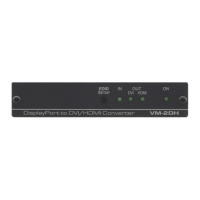3.2 About HDMI
High-Definition Multimedia Interface (HDMI) is an uncompressed all-digital
1
audio/video interface, widely supported in the entertainment and home cinema
industry. It delivers the highest high-definition image and sound quality.
In particular, HDMI
2
:
• Provides a simple
3
interface between any audio/video source, such as a set-
top box, DVD player, or A/V receiver and video monitor, such as a digital
flat LCD / plasma television (DTV), over a single lengthy
4
cable
• Supports standard, enhanced, high-definition video, and multi-channel
digital audio
5
on a single cable
• Transmits all ATSC HDTV standards and supports 8-channel digital audio,
with bandwidth to spare to accommodate future enhancements and
requirements
• Benefits consumers by providing superior, uncompressed digital video
quality via a single cable
6
, and user-friendly connector
• Is backward-compatible with DVI (Digital Visual Interface)
• Supports two-way CEC communication between the video source (such as a
DVD player) and the digital television, enabling new functionality such as
automatic configuration and one-button play
HDMI has the capacity to support:
Existing high-definition video formats (720p, 1080i and 1080p, 2K and 4K) as well
as standard definition formats such as NTSC or PAL
3.3 Defining the EDID
The EDID
7
is a data-structure provided by a display that describes its capabilities
to the source. The EDID enables the VM-2DH to “know” what kind of monitor is
connected to the output. The EDID includes the manufacturer’s name, the product
type, the timing data supported by the display, the display size, luminance data and
(for digital displays only) the pixel mapping data.
1 Ensuring an all-digital rendering of video without the losses associated with analog interfaces and their unnecessary digital-to-analog
conversions
2 HDMI, the HDMI logo and High-Definition Multimedia Interface are trademarks or registered trademarks of HDMI licensing LLC
3 With video and multi-channel audio combined into a single cable, the cost, complexity, and confusion of multiple cables currently
used in A/V systems is reduced
4 HDMI technology has been designed to use standard copper cable construction at up to 15 m (49ft)
5 HDMI supports multiple audio formats, from standard stereo to multi-channel surround-sound. HDMI has the capacity to support
Dolby 5.1 audio and high-resolution audio formats
6 HDMI provides the quality and functionality of a digital interface while also supporting uncompressed video formats in a simple, cost-
effective manner
7 Defined by a standard published by the Video Electronics Standards Association (VESA)

